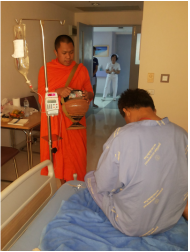 Making merit is one of the most common practices of Thai Buddhists. It is also one of the least understood by outsiders (by whom I mean those not deeply oriented to Thai culture). It is not uncontroversial among Buddhist scholars, either. For those of us who are immersed in Thai village life, merit-making is both universal and sometimes overlaps other venerations. Making a contribution of food to Buddhist priests is probably the most common tradition of merit making in Thailand. This is called “tak bahtr” or “binta bahtr” which is literally to dip or ladle rice into a monk’s alms bowl. Therefore the term refers to giving offerings to priests by placing them into the bowls either carried by the priests or arranged for that purpose on a table. A bahtr is a round wide-mouth bowl or pot made of clay, bronze or iron without ornamentation. I have transliterated the word with a final R (which is not pronounced) because that is the way the word is spelled, and it is not same spelling as the Thai money or weight of precious metal called a baht. The monk’s bahtr has a lid that was traditionally used as a plate. In some communities monks still sally forth early in the morning, walking barefoot, with their bahtr in a sling over their shoulder to collect food for themselves and other monks in the temple. This is not begging, but an act of compassion on the part of the monks. By going out to the people they make it easier for busy folks to earn merit and to express their devotion to Buddhism. Here in our village the custom is for village units to take turns taking food to the temple for our two monks, who are not young anymore. On special occasions almost everyone in the village goes to the temple with food to tak bahtr. It is understood that the tradition is older than Buddhism. Before the Buddha, the people made offerings of food to ascetics and Brahmans. That was how those mendicants were fed. As the Buddha was starving himself in a desperate attempt to excel at asceticism in order to achieve his break-through to enlightenment, a young woman brought him a plate of rice. He realized that extreme asceticism would not work, so he accepted the rice and re-directed himself down a middle-pathway of sufficiency. Every incidence of tak bahtr commemorates that middle path and affirms it. In this spirit a monk came to the hospital the other day when we were there as Pramote, my spouse, was a patient. The opportunity to tak bahtr was not to be missed. Pramote, all hooked up to his IV drip, put his contribution into the bahtr and then received a blessing. He was hopeful it offset at least part of the bad deeds or consequences that had put him in the hospital.
0 Comments
Leave a Reply. |
AuthorRev. Dr. Kenneth Dobson posts his weekly reflections on this blog. Archives
March 2024
Categories |
| Ken Dobson's Queer Ruminations from Thailand |
|
 RSS Feed
RSS Feed
